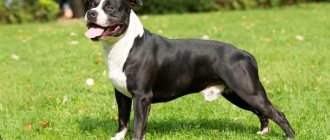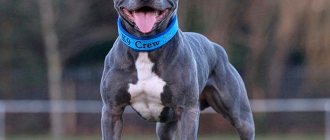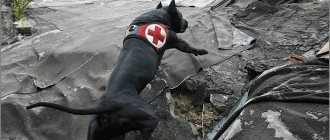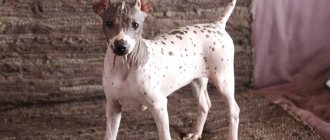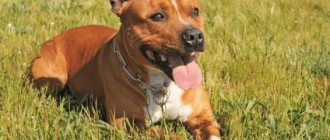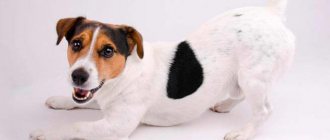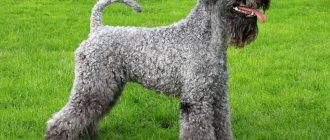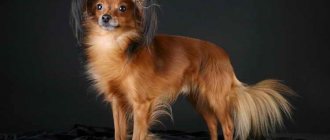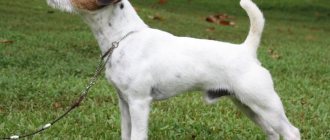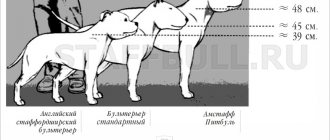| Origin: | USA (XX century) |
| Usage: | fighting, bodyguard |
| Color: | white, black, blue, brindle (solid, combined, spotted) |
| Dimensions: | height: 43-48 cm; weight: 25-30 kg |
| Lifespan: | 11-16 years old |
Amstaff is the short name for a North American species that appeared at the beginning of the 20th century. The dog's predecessors were bulldogs and game terriers. The Staffordshire Terrier appeared to the world as an excellent defender of territory; over time, individuals began to constantly participate in dog fights.
Breed standard
The American Staffordshire Terrier has a very recognizable appearance: the breed standard was approved in 1935.
The fighting breed is large in size, well built, and has a muscular build. At the same time, the Amstaff is elegant, agile and quickly reacts to what is happening around.
It’s worth immediately understanding what a Staffordshire Terrier looks like: the photos show the most common external appearance of individuals. The breed standard describes the dog as follows:
- The head of the Stafford is of medium size, the transition from the frontal zone to the muzzle is clearly visualized, the ears are located high;
- Previously, the ears of the Staffordshire Terrier were cropped; at the moment, this event is banned in most regions. In the original position, the Amstaff's ears are raised and slightly shortened. Uncropped shells cost little. If the staff's ears droop, this is considered a defect;
- Amstaff's eyes are small, round in shape, dark;
- the muzzle of the Staffordshire Terrier is distinguished by a pronounced jaw relief and a rounded nasal dorsum;
- The Amstaff Terrier has a dense build: with a muscular neck, broad shoulders, and oblique shoulder blades;
- The Amstaff's tail is set low, becomes narrower towards the end, docking is not performed;
- The breed's coat is short and shiny;
- The front legs of the Staffordshire Terrier are set wide apart and the gait is springy.
A description of the breed cannot be completed without mentioning the colors of the Staffordshire Terrier. The black shade of the Amstaff's fur is thick and rich (small marks may form on the nose and on the paws). A combination of white and black shades is possible (a light tone is noted in the area of the muzzle, neck, back and paws).
A blue dog has a nose of the same tone. The blue staff with blue-black fur boasts an almost black tip. The brindle or red Amstaff has a bright and even color with a reddish tint. There is also chocolate, grey, brown and white Stafford.
The first standard of the American Staffordshire Terrier was drawn up by W. Brandon, the future president of the Breed Club (STCA).
History of the origin of the breed
The history of this breed has deep medieval roots. Even before 1800, gladiator fights were held in England to entertain large crowds of people who needed very little: bread and circuses. Both people and animals took part in the fights. Over time, the fights became more and more humane and people stopped participating in fights, but the crowd still needed to be entertained and they decided that dogs would participate in the fights. As a rule, they used dogs to set bulls against each other.
The king and his nobles did not stop at just bulls, so the dogs set monkeys, lions, bears, tigers, etc. Until this period in history, dogs were not known for such aggression, so it was man himself who was to blame for the fact that dogs became so aggressive. The Earl of the English city of Stamford was looking around from his balcony and a picture of two bulls fighting caught his eye.
One bull could not stand the confrontation and ran away, then the dogs chased after it to bring it back. The count liked this picture and ordered that bull fights with dogs be held annually.
The nobility liked such fights and such massacres were practiced more and more often. This was the impetus for people to start breeding special fighting breeds. Basically, mastiffs and bulldogs were used, which were heavyweights on the “battlefield”. Their weight often got in the way, and they died under the hooves of horses. Therefore, they began to pay attention to individuals who were distinguished by their strength, but at the same time were quite mobile and maneuverable. Since then, they began to select bulldogs precisely according to this principle.
Interesting fact! In 1835, the English Parliament prohibited by law any kind of fights involving bulls. Despite this, people did not stop and continued fighting, but only dogs with dogs.
During this period, breeds appeared that are considered the ancestors of modern Staffordshire Terriers. This is a bulldog and terrier mix. In those days, the bulldog was an animal that weighed more than 20 kg and had high legs, an elongated muzzle and a long tail. The terrier, or rather the fox terrier, differed from the bulldog in being much smaller in size, but at the same time had greater mobility, temperament and attacking character. As a result of crossing these breeds, another breed, the Bull and Terrier, appeared, which had the qualities of both a bulldog and a terrier, which was ideal for fighting.
From this point on, Bull and Terriers were always present and took part in dog fights. The fights had their own rules and were therefore clearly regulated. The battles were held in rings made of wood. As a rule, individuals with good wrestling qualities were selected for battle. After some time, this breed began to be called “pit dogs” and “pit bull terriers.” Beginning in 1870, pit dogs were brought to America, where they were used in the same capacity. At the same time, many breeders noted the fact that some dogs do not show aggression, are drawn to people and are friendly.
From this moment on, some breeders, led by W. Brandon, began to select individuals who showed a peaceful character in order to develop the qualities of companions and helpers in dogs. These were friendly individuals who reacted calmly to other animals. It was only in 1936 that the breed was officially registered under the name "American Staffordshire Terrier" to draw the line between such breeds as "Pit Bull Terrier", "Bull Terrier" and "Staffordshire Terrier".
Types of amstaffs
There are three types of dogs depending on their build (body proportions, weight and height):
- Proportional amstaff. Weight of an adult dog: up to 30 kg. The body is rectangular, has the dimensions of a bulldog, the temperament of a terrier, the loin is of appropriate length, and the ideal appearance of the hind legs.
- Bulldog Amstaff. The weight of a Staffordshire Terrier of this type is more than 45 kg. The breed is distinguished by its short neck, rough build, and lack of mobility.
- Terrier Amstaff. The Stafford dog breed of this variety weighs about 30 kg. The animal has an elongated, narrow mouth and a long neck. It is characterized by an irregular angle of the glenohumeral joint.
The most valuable representatives of the breed are individuals of the first group. They lack the unattractive characteristics of their progenitor individuals and are rare.
Training and education
Despite the waywardness of the American Staff Terrier, it is not difficult to train. The dog is very smart, quickly remembers commands, but from the first lessons you need to instill in him that the owner’s word is inviolable. If the owner is inexperienced, he may have serious problems with raising and training the staff. The dog is prone to dominance; when it senses weakness on the part of the person, it will try to become the leader. In such cases, it is recommended to seek help from an experienced dog handler who will help carry out the training correctly.
It is worth familiarizing yourself with some rules for raising Staffordshire:
1. You cannot change the rules that were established for the dog. For example, if you forbid your pet to lie in a chair or on the sofa, never allow him to do this. The ban must be in effect all the time, without temporary concessions. Otherwise, the dog will decide that the owner’s orders can be ignored. 2. Under no circumstances should you show your weakness to the staff; in his eyes you must be the leader. 3. It is forbidden to encourage a dog’s aggressive behavior, much less develop aggression in it. 4. The owner of a Staff Terrier should not limit the dog’s training to initial commands, such as “no”, “sit”, “near”, etc. Such a serious dog must undergo a general training course or a “dog in the city” course.
Interesting Facts
- A record was recorded when a Staffordshire Terrier was able to drag a load weighing 135 kg. Considering that the weight of such a dog is about 30 kg, then this case is the height of endurance and power.
- Representatives of the breed have proven themselves in the service of the Ministry of Emergency Situations.
- One of the admirers of Amstaffs was Yuri Nikulin; he more than once spoke out in defense of dogs when charges were brought against them for hating people.
Character
Contrary to popular belief, the Amstaff is a very friendly animal towards humans. The dog is devoted to the owner and his entire family. The Staffordshire Terrier and children are a completely harmonious union. When playing with small family members, the individual is good-natured and gentle. Amstaff attacks only in case of obvious danger.
If you believe the Stafford breed standard, the Amstaff's character excludes unjustified aggression towards people - the dog is not dangerous. The breeders deliberately eliminated specimens that behaved aggressively and left exclusively human-oriented dogs.
Among the qualities inherent in the Amstaff breed are:
- courage;
- endurance;
- force;
- devotion;
- high intelligence.
Since it is logical to analyze the pros and cons of the breed, it is worth warning future dog owners that the animal does not know how to ignore the owner’s command. In this matter, the key point is the adequacy of the owner. Another disadvantage of the animal can be considered the constant need for attention from family members. Keeping such a dog on the street is a sin. Even if you build an enclosure for an animal, the dog will not be able to live there: it prefers the comfort of home.
Where and how to buy a puppy
First of all, it should be noted that purchasing a dog of this breed is a crucial stage in a person’s life.
What to pay attention to
It is very important to adhere to the standards when purchasing a puppy of this breed. The fact is that the standard coloring, shape of the paws and the whole body indicate that the dog does not have any impurities at the genetic level.
In connection with this factor, you can safely count on a standard behavior, which is very important. In the case of any impurities that cannot be documented, it is possible to purchase a dog with various abnormalities, including in its behavior. In other words, you can buy an angry and bloodthirsty dog with whom it will be difficult to communicate normally. You should also pay attention to whether the nursery is engaged in legal activities and whether there is an appropriate document for each animal.
If the nursery is legal, then all individuals have a pedigree. You should pay attention to the behavior of the puppy so that it is calm and balanced, and also reaches out to the person. It is also necessary to find out what kind of births the female has had and whether genetic abnormalities occurred in previous births.
Important information! Puppies with a calm character and under 2 months of age are selected. The sooner you start training your dog, the better.
Puppy cost
The cost of puppies depends on a number of factors, such as pedigree, availability of documents and class of kennel. Without any documents, you can buy a puppy that looks like an American Staffordshire Terrier for 5 thousand rubles. If you take a puppy from a nursery, then prices here only start from this amount. If the breed has documentary evidence, then you will have to pay up to 30 thousand rubles for the puppy.
Relationships with other animals
The Stafford dog breed is quite tolerant of other pets. This is a significant advantage, considering how many years dogs live. The characteristics of animal relationships depend on the approach of the owners.
If the pets are identical in age, it will be more difficult for them to establish contact. When a younger individual, be it a hamster or a parrot, moves into a house with an Amstaff, the dog shows noticeable friendliness and is playful, provided there is no aggression on the part of the “new friend.” Amstaff and a cat are a controversial friendly alliance, since staffs have a threatening appearance, which is regarded accordingly by the cat.
Psychology
The Taffordshire Terrier dog is an intelligent and kind dog, which is not characterized by sudden outbursts of aggression.
Norwich Terriers have the same breed characteristics . He loves kids, is ideal for large families and will become a devoted friend.
Of course, only proper education will allow the breed to show all its best qualities.
Characteristics of the Staffordshire Terrier dog breed:
- Obedience and ease of training. The dog of this breed is very smart and easy-going, he easily remembers what can be done in the house and what actually cannot be done, if you devote enough time to training during puppyhood. Training a staff is not difficult; even a child over 10 years old can handle it quite well under the close supervision of their parents.
The Staffordshire Terrier dog has a very menacing appearance. But behind the outer shell lies kindness and playfulness.
- Activity. The Staffordshire Terrier loves active pastime, he loves to run , walk, jump a lot, the more games you can offer your pet, the better. This rule of active life also applies to Russian and Afghan hounds , as well as Greyhound dogs . Staffords are not suitable for homebodies; the pet will “pour out” unspent energy at home, disrupting order. Therefore, it is important to spend a lot of time walking and providing the dog with various types of activity.
- Kindness. Many people believe that the Staffordshire Terrier, a photo of which can easily be found on dog forums, has an aggressive character and does not like strangers. This is not true, this breed is very social, it loves children and loves when guests come to the house. But with the same friendliness she treats other dogs that she meets during her walk. The Staffordshire Terrier dog breed is perfect for those who want to find a faithful friend for the whole family.
Stafford loves active pastime, she likes to walk a lot, run, jump, the more games you can offer your pet, the better
How to choose a puppy
The algorithm for choosing an Amstaff depends on why the owner needs a Stafford dog. How to choose a puppy - the future guard? The basic principle is to assess the poise of the Staffordshire Terrier. Before this, it is worth determining the age of the individual. If you have to deal with an aggressive two-month-old Stafford, it is impossible to turn him into a friendly dog that will not leave the enclosure. A balanced Staffordshire Terrier at the age of 2 months will be an excellent bodyguard. However, the character of the Staffordshire Terrier may change if the dog is kept outside and communication with it is limited.
If the owner intends to attend exhibitions with the dog or breed puppies, he will not only have to determine the age of the proposed Staffordshire Terrier and evaluate its temperament, but also pay attention to whether the Amstaff puppy has the following disadvantages:
- liver and black-fawn color;
- snack;
- light eye color;
- beige lobe;
- jaw distortion;
- lack of hearing;
- long or docked tail;
- amble.
Is it possible to buy a dog with a deficiency? Yes, but the road to exhibitions with such a staff representative is closed.
Application
Many people believe that the American Staffordshire Terrier is an excellent guard dog for the home.
But in fact, it is important to educate the animal so that it learns the behavioral characteristics of a protective dog.
Today, a dog of this breed is kept as a pet, a guard, and even a rat catcher.
Stafford does well in the home, is not aggressive towards strangers and loves spending time with children.
This dog is friendly and loves company, so it will become an indispensable friend for the family.
A dog of this breed is not suitable for homebodies; the pet will “pour out” unspent energy at home, disrupting order. Therefore, it is important to spend a lot of time walking and providing the dog with various types of activities.
Features of maintenance and care
Keeping and caring for the Staffordshire Terrier is quite difficult. However, as evidenced by reviews from dog owners, Staffordshires are very tolerant: they are easy to scratch and wash. Amstaffs are unpretentious in food. How to care for the Staffordshire Terrier and how to maintain it will be discussed further.
Combing/grooming
Amstaff grooming includes:
- coat care. Even in an apartment, this is not difficult to do - just brush the dog once a day with a special brush;
- Caring for the ears and eyes of an Amstaff puppy. The Staffordshire Terrier's eyesight should be wiped with cotton wool daily. Ears – clean 2 times every 7 days with ear sticks;
- nail care. Amstaff's nails need to be cut as they grow. Once every 30 days is usually enough.
Bathing
Stafford dogs love to swim. Water procedures should be performed no more than once every 8-10 weeks. It is worth using special products for short-haired dogs. Before starting the procedure, it is necessary to check the Amstaff's body for scratches, wounds and other damage.
Walk
Staffordshires are active representatives, so you need to walk them daily. Usually 2 walks of 1.5 hours are enough. You should work out with amstaff in a separate place.
Feeding
It is impossible to know everything about the breed without knowing how to feed the dog. 70% of the amstaff's daily diet should be raw meat. The Staffordshire Terrier breed needs a high-quality source of protein, which for the animal will be finely chopped lean meat. Other foods that Amstaff dogs can eat include:
- fresh fermented milk products;
- animal entrails, previously well boiled;
- chicken eggs (it’s better to make an omelet);
- fresh vegetables with vegetable oil (beets, spinach, pumpkin, etc.).
Staffords should not eat boiled potatoes, porridge, peas, beans, or pork dishes. Staffordshire Terrier puppies cannot chew bones until they are 7 months old.
Keeping a Staffordshire Terrier
Proper care and care for the animal makes man and dog more united. The basis of keeping a dog includes such measures as maintaining hygiene, balanced nutrition, as well as mandatory education.
Hygiene and care
This breed has short and smooth hair, but despite these characteristics, it must be brushed regularly with a special brush. If the dog participates in exhibitions, then it must be bathed, although this breed loves plenty of water treatments, regardless of whether it participates in exhibitions or not. Before bathing, you must carefully examine the animal for wounds or cuts. If there are any, then the bathing process must be canceled.
Interesting to know! To add shine to your dog's coat after bathing, you should use car suede, which is simply wiped over the coat.
After this procedure (bathing procedure), the dog should not emit any foreign, much less unpleasant, odors. If they are present, the animal should be shown to a veterinarian. The appearance of a foreign or other unpleasant odor may indicate the presence of an infectious disease. You need to walk your pet for at least an hour and a half every day. Moreover, you need to walk your dog only in specially designated areas. In places where there are a lot of people and strange dogs, your dog must be kept on a leash and muzzled. This will protect both the animal and the owner from the negative influence of drunk people, as well as stray dogs.
It is necessary to regularly examine the eyes and ears of your pet, and if necessary, they should be cleaned with a cotton pad soaked in warm, boiled water. In case of redness, problem areas are treated with chamomile infusion using the same cotton pads. Regular and thorough care of the anal glands is necessary, but this procedure is best performed by a specialist. This is especially true for the first time. Having mastered this procedure under the supervision of a doctor, such actions will not be difficult to do independently at home.
Dog diet
There are 2 options for feeding your dog: using natural ingredients or dry, store-bought food. Any of the options requires the use of exclusively high-quality components. In the case of feeding natural food, it is necessary to carefully consider the diet so that the food is balanced and includes a variety of nutritional components, including vitamin supplements and various microelements. When dry, purchased food is used as the basis for nutrition, preference should be given to premium or super-premium food from well-known manufacturers. Such food is optimally balanced in terms of nutrients and is harmless to the health of your pet.
The use of dry food does not require additional vitamin supplements. When feeding, it is necessary to follow a strict regime, adhering to the same time. As a rule, this happens after a walk. After eating, you must immediately remove any leftover food. As for water, the dog should have clean drinking water at all times, regardless of meal times.
The basis of natural nutrition should be:
- Animal proteins, which are found in raw and boiled beef, chicken, turkey, liver, offal and fish. It is acceptable to give your dog lamb twice a week.
- Fermented milk products in the form of cottage cheese, kefir and yogurt. Once a week you can give cottage cheese and eggs mixed.
- Porridge, with the addition of meat, vegetables or herbs. Rice, buckwheat, oatmeal or corn grits are suitable for preparing porridge.
- Offal that dogs simply love. This type of food is best served boiled.
- Fish, which is no less useful for a dog, and you need to give the fish without bones, or stew the fish so that the bones are soft.
Sugar or back bones can be given to puppies who are starting to teethe. However, it is not recommended to give bones to adult dogs frequently, as this leads to constipation and damage to tooth enamel.
It is prohibited to give your dog the following food:
Sausages, sausages, cookies and candies, as well as table scraps, since the animal’s stomach is not designed to digest fatty foods, seasonings and various other food additives. You should also not feed your pet salty, sweet, smoked, spicy, fatty, or unhealthy food with mold.
It is important to know! If there is excess food, the breed begins to develop obesity, which negatively affects its health.
In the case of using ready-made dry food, as mentioned above, you should not buy cheap ones, which have minimal benefit and more harm. In order for the animal to please the owner and family members with a cheerful, healthy disposition for many years, it is better to buy products from well-known manufacturers of the highest class, such as Royal Canin, Hills, Acana, Grandorf and others.
American Staffordshire Terrier. The truth about the breed.
Diseases and breed defects
The American Staffordshire Terrier is in excellent health, but, like all other dog breeds, it is susceptible to viral diseases, so the task is to get all the necessary vaccinations in a timely manner. This breed has a rather vulnerable digestive tract, so it is very important to choose the right diet and not feed the animal more than normal. In addition, the breed has specific health problems. For example:
- Skin lesions (dermatitis).
- Colitis.
- Manifestation of allergic reactions.
- Inflammation of the genitourinary system.
- The appearance of benign neoplasms.
- Problems with the musculoskeletal system.
- Eye problems, such as entropion, conjunctivitis, cataracts, etc.
There is also the most unpleasant breed defect - ataxia, which represents damage to the cerebellum at the genetic level. Unfortunately, until the dog is 3 or 5 years old, this disease does not manifest itself in any way. After this age, symptoms begin to develop quite quickly, as a result of which the dog’s coordination of movements suffers.
Education and training
To train a dog, you need to determine your motivation. There are three types of motivation:
- Food.
- Social.
- Gaming.
This breed responds positively to all three types of motivation, so the training process is accompanied by tangible progress.
Important information! The training process should be daily and last at least 2 hours. Otherwise, it is unlikely that a positive result will be achieved.
This breed will always punish its owner for weakness of character and inconstancy. You should never follow the lead of an animal, since this animal is distinguished by its stubbornness and strength of character. Therefore, from the very beginning the dog needs to be shown “who’s boss.” It is very important to communicate with the dog as with an adult, and not as with a child, allowing him everything. Commands should be voiced firmly and confidently, with the same insistent intonations.
It is very important that the pet immediately understands that any commands must be carried out only with the permission of the owner, including the “fas” command. It is also important that the attitude of all other family members be just as tough, without signs of connivance, adhering to the same line of upbringing. At the same time, there is a set of basic commands that the American Staffordshire Terrier must master. For example:
- Command "Sit" . Firstly, you need to clearly and clearly pronounce this command and show a piece of treat. After the puppy sees this piece, it is raised high. Naturally, the puppy will reach for food, but he will not get it and immediately sits back. At this moment, you need to help the puppy sit down with your hand and say this command again. After this, the puppy should receive his treat. As a result, a cause-and-effect relationship will be established between the execution of the command and the reward.
- Command "Come to me" . This command should be given at a time when the animal is at a distance and in the field of view of the owner. At the moment the command is given, a treat should be shown. After the dog comes running, you need to give the command “Sit” and give it a treat.
- Command "Lie down" . This command is learned by the pet in the same way as the “Sit” command, but in a different position.
- Team "Near" . The puppy should be taught this command during walks, as well as after physical activity.
- The “Place” command is learned by the puppy before bed, when he is on his bedding.
- Team "Aport" . The puppy is taught to perform this command during outdoor games.
The most important thing is not to take any breaks and engage in training constantly, every day and purposefully. Under no circumstances is it recommended to overload the animal. This means that you need to have certain skills for this important process. As a rule, they are not enough, just as there is not enough time and patience. In this case, it is better to seek help from specialists, which can guarantee that the dog masters all the necessary commands.
Health
The Stafford dog breed has a strong immune system and rarely gets sick. However, it is impossible to say that Staffordshire dogs are insured against diseases.
Diseases
Among the probable hereditary pathologies:
- Lameness. The cause of the pathology is improper formation of the hip joint. More often observed in fighting Amstaffs.
- Deafness. This type of minor deafness is not dangerous for a dog: the animal gets used to it and lives a normal life. Individuals with complete deafness cannot be trained. Diagnosis of the disease becomes fatal for the Staffordshire Terrier.
- Licked granuloma. It is a wound on the skin that appears in response to constant exposure. How to determine pathology? If the Amstaff frequently licks and bites one area of the skin, it is worth checking for a wound. The disease is treated by superficial treatment.
- Turn of the century. The dog needs surgery.
Vaccinations
Vaccinations for Amstaff puppies begin at the age of 6-8 weeks. Before the procedure, the animal needs to be dewormed. The same vaccination is repeated after a month. Staffordshire dogs are vaccinated against rabies at 12 weeks (the procedure can be carried out at 9 months or a year).
The full list of vaccinations given to Amstaff dogs depends on the dog’s living conditions. If he is susceptible to ticks, he may want to consider getting a Lyme vaccine.
A Staffordshire Terrier usually tolerates all vaccinations well if he was previously healthy. After vaccination, the dog should not be bathed; it is recommended to limit contact with other animals.
Video description of the breed
The American Staffordshire Terrier is not a breed for everyone. Such a dog is not suitable as a gift for a small child, or for those who like to spend time in front of the TV screen. Staff dogs require a lot of time, attention, and effort from the owner to raise the dog.
If the fighting breed is illiterate or insufficiently trained, it becomes a real threat to others. Before purchasing an Amstaff, you should think carefully about whether you can provide the dog with proper care. But if you manage to find a common language with this warrior, he will become the most devoted friend, a reliable protector for all family members.
Breeding
Mating is a very delicate process for this representative. Many male dogs have a calm temperament and need time to get used to the female. For these purposes, animals should be introduced even before the female starts estrus. Other types of males (usually belonging to the first type of physique) are capable of mating even at the time of the first meeting.
Pregnancy, even in the case of successful contact, may not occur immediately due to the female’s tension. Is it possible to bring individuals together again in this case? Experts give a positive answer to this question.
How much do puppies cost?
It's time to find out how much amstaff costs. In Russia, the price of purebred puppies varies significantly and depends on the color and class of the dog:
- amstaff with veterinary documents - from 50 thousand rubles;
- show-class animal (with documents from the veterinary hospital, pedigree and passport) - from 80 thousand rubles;
- Amstaff without documents and pedigree - up to 32 thousand rubles.
How much does a brindle puppy cost? The price of such representatives starts from 5 thousand rubles. If we are talking about red Amstaffs, they will cost 5 times more. Black and white dogs cost about 6 thousand rubles.
Nurseries
You can purchase a purebred individual in one of the country’s nurseries, for example, here:
- Imperial Giant Chance - https://imperial-gigant.ru
- Wulf - https://staffstyle.ru/cgi-bin/yabb2/YaBB.pl?num=1208062704.
You can also purchase a pet from dog handlers. It is worth buying an Amstaff from nurseries and dog breeders if the owner intends to purchase an animal with a pedigree and a passport. If we are talking about staffs who in the future become faithful pets, they can be found in pet markets or by advertisement.
Characteristics of the Staffordshire Terrier breed: height, weight, color, temperament, combined with the dog’s devotion, tolerance and activity, paints a rather attractive portrait. However, this dog is not suitable for everyone: keeping an Amstaff and caring for the animal require time and attention. If the future owner is not ready for the painstaking work of raising a pet, it is not worth purchasing an American fighting dog.
Pros and cons of the breed
Like any breed, the American Staffordshire Terrier has its positive and negative sides.
We present the main ones in table form.
| pros | Minuses |
| stable psyche | needs serious training |
| good health | tendency to joint diseases |
| developed intelligence | stubbornness |
| suitable for apartment living | requires regular walking |
| devotion to the owner | wary of strangers |
| easy to care for | desire for dominance |
The disadvantages attributed to the breed are often caused not by the characteristics of the dog itself, but by the inability of people to properly raise and care for their pet.
